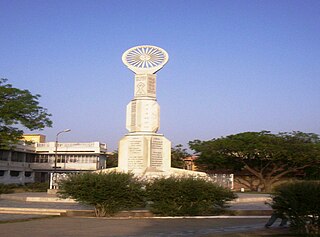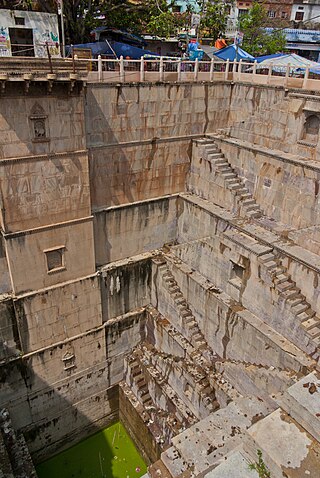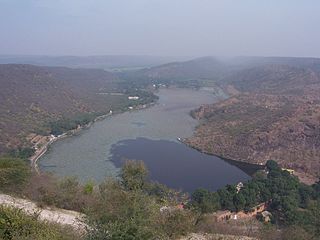
Amber or Amer, is a city near Jaipur in Jaipur district in the Indian state of Rajasthan. It is now a part of the Jaipur Municipal Corporation.

Hindaun is a city and municipality, near city of Karauli in Karauli district, Rajasthan, India. It has a population of 105690 and is governed by a municipal council.

Bundi is a district in the state of Rajasthan in western India. The city of Bundi is the district headquarters. It has an area of 5,550 km2 and a population of 1,110,906. It is divided into 5 tehsils which are: Bundi, Hindoli, Nainwa, Keshoraipatan and Indergarh.

Stepwells are wells, cisterns or ponds with a long corridor of steps that descend to the water level. Stepwells played a significant role in defining subterranean architecture in western India from 7th to 19th century. Some stepwells are multi-storeyed and can be accessed by a Persian wheel which is pulled by a bull to bring water to the first or second floor. They are most common in western India and are also found in the other more arid regions of the Indian subcontinent, extending into Pakistan. The construction of stepwells is mainly utilitarian, though they may include embellishments of architectural significance, and be temple tanks.
Aklera is a town and an Indian municipality in Jhalawar district in the state of Rajasthan. It is in the south-eastern region of Rajasthan at the edge of the Malwa plateau and has a rocky, scrub-covered terrain.

Bijoliya is a census town in Bhilwara district in the state of Rajasthan, India and is surrounded by nature and waterfalls and is famous for Tapodaya Teerth Kshetra and Mandakini Temple.
Jahazpur is a historical town and a municipality in Bhilwara district in the Indian state of Rajasthan. It is also the tehsil headquarters of the Jahazpur tehsil. It is known for the Jain temple swastidham, built around the Jahazpur fort.
Lakheri is a town and municipality in Bundi district in the Indian state of Rajasthan. It is located in the southeast of Rajasthan, around 180 kilometres (112 mi) south of the state capital, Jaipur. Lakheri has been a subdivision headquarters since 2002. Yugantar Sharma (RAS) is the Sub-division Officer and magistrate of Lakheri subdivision. It is the second largest city in the district, after Bundi and 104th largest city in rajasthan.
Nainwan is a tehsil of Bundi district and a municipality in the Hadoti region of the state of Rajasthan in India.
Uniara is a town and a municipality in Tonk district in the Indian state of Rajasthan. It is a tehsil of the Tonk district.

Rajasthan is one of the most popular tourist destinations in India, for both domestic and international tourists. Rajasthan attracts tourists for its historical forts, palaces, art and culture with its slogan "Padharo Mhare Desh " The capital city, Jaipur, also known as Pink City, is a very popular tourist destination and is a part of the Golden Triangle. The Walled City of Jaipur is only the second Indian city to be recognized as a UNESCO World Heritage Site, after Ahmedabad.
Hada are a branch of the Chauhan Rajput community. They live in Hadoti and once ruled the states of Bundi, Jhalawar and Kota.

Hindaun is a Block in Karauli district of the Indian state of Rajasthan in Northern India. It is a subdivisional headquarter. Its population is approximately 442,000. The block covers an area of 700 Square kilometres, which makes it the biggest block in Karauli. The subdistrict code of Hindaun Block is 00522. There are about 165 villages in Hindaun Block.

The Nagar Sagar Kund are twin stepwells in the city of Bundi, Rajasthan, India. Located near the Raniji Ki Baori stepwell and decorated with sculptures, they are no longer in use to this day.

The Garh Palace is a fortified palace located on the outskirts of Kota, Rajasthan. It was the former residence of the Maharaos of the Kingdom of Kota. It is also known by various other names, like City Palace, Kota Garh, and Kota Fort. The Garh Palace is home to a vast heritage collection of canons, paintings, armour, palaces, instruments, attire, manuscripts, murals, and buildings, some of which date back to the 13th century. The Maharao Madho Singh Museum occupies the ground floor of the palace building.

Jait Sagar Lake is an artificial lake or reservoir situated in Bundi city in the state of Rajasthan in India. It is surrounded by the hills of the Aravalli mountain range. This lake, near Taragarh Fort, is filled with lotus flowers during winter and monsoon seasons. Jait Sagar is surrounded by towering walls and has four gateways that serve as entry points to the lake. It is located at a distance of less than 3 km from Bundi city.

Taragarh Fort is a fort located in Bundi, Rajasthan, India. Located high on a hill of aravalli mountain range, it is the principal tourist attraction in Bundi. The fort was built here on a steep hill at a height of 1426 feet. Many tunnels were made in it to exit the fort during the battle. These tunnels are visible at many places in the mountains.

Nawal Sagar Lake is an artificial lake or reservoir situated in Bundi city in the state of Rajasthan in India. It is surrounded by the hills of the Aravalli mountain range. It is a square shaped artificial lake, and a temple dedicated to Varuna, the God of ocean, is partially submerged in the middle of the lake. Nawal Sagar is surrounded by towering walls and has two gateways that serve as entry points to the lake. It is located in the centre of the Bundi city.

Bundi Utsav, or Bundi Festival, is an annual cultural and tourism festival celebrated in the city of Bundi, located in the Hadoti region of Rajasthan, India. This vibrant festival showcases the rich cultural heritage, traditional art forms, and historical significance of Bundi. It typically takes place in the month of November and spans over three days, attracting both domestic and international tourists.

The Conquest of Hadoti was a significant military expedition led by Sultan Mahmud Khalji of Malwa against Hadoti. The primary objective of this campaign was to capture Bundi, Kota and Jhalawar, which were under the command of Bairisal, a subordinate of Rana Kumbha. Mahmud Khalji marched towards Hadoti in the year 1457-1458 A.D. to achieve this goal.


















